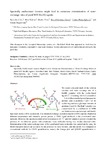Mostrar o rexistro simple do ítem
Spectrally undiscerned isomers might lead to erroneous determination of water exchange rates of paraCEST Eu(III) agents
| dc.contributor.author | Cakic, Nevenka | |
| dc.contributor.author | Tickner, Ben | |
| dc.contributor.author | Zaiss, Moritz | |
| dc.contributor.author | Esteban-Gómez, David | |
| dc.contributor.author | Platas-Iglesias, Carlos | |
| dc.contributor.author | Angelovski, Goran | |
| dc.date.accessioned | 2018-11-28T13:42:38Z | |
| dc.date.available | 2018-11-28T13:42:38Z | |
| dc.date.issued | 2017-07-17 | |
| dc.identifier.citation | Spectrally Undiscerned Isomers Might Lead to Erroneous Determination of Water Exchange Rates of paraCEST Eu(III) Agents. Nevenka Cakić, Ben Tickner, Moritz Zaiss, David Esteban-Gómez, Carlos Platas-Iglesias, and Goran Angelovski. Inorganic Chemistry 2017 56 (14), 7737-7745. | es_ES |
| dc.identifier.issn | 0020-1669 | |
| dc.identifier.issn | 1520-510X | |
| dc.identifier.uri | http://hdl.handle.net/2183/21407 | |
| dc.description.abstract | [Abstract] We report a detailed study of the solution structure and water exchange rate of a Eu(III) complex with the cyclen-based ligand L1, containing (S)-2-(2-acetamido)-3-(4 (trifluoromethyl)phenyl)propanoate pendant arms at positions 1 and 7 of the cyclen ring and acetylglycinate pendants at positions 4 and 10. The EuL1 complex was characterized by a combination of NMR and luminescence spectroscopy and density functional theory (DFT) calculations. The chemical exchange saturation transfer (CEST) spectra obtained at different temperatures and saturation powers present a CEST signal attributed to the coordinated water molecule. However, the spectra recorded at low temperatures (10 °C) and low saturation powers revealed the presence of two different species with coordinated water molecules having very similar chemical shifts. Determination of the water exchange rates of the coordinated water molecules was carried out by using the Bloch four-pool model that accounts for the presence of these isomers, and this model was compared to conventional methods for CEST quantification, namely the Omega plot and QUESP (quantification of exchange rate as a function of saturation power), which assume the presence of a single CEST active species. The results indicated that only the four-pool Bloch equations provide reasonable water exchange rates and activation parameters. Solution NMR studies and DFT calculations indicated that the two isomers present in solution correspond to the SS-Δ(λλλλ) and SS-Λ(δδδδ) isomers, which present capped square-antiprismatic (SAP) coordination environments. Additional NMR studies on the EuL2 and EuL3complexes, which present four (S)-2-(2-acetamido)-3-(4-(trifluoromethyl)phenyl)propanoate or acetylglycinate pendant arms, respectively, confirm the results obtained for EuL1. | es_ES |
| dc.description.sponsorship | Ministerio de Economía y Competitivad; CTQ2015-71211-REDT | es_ES |
| dc.description.sponsorship | Ministerio de Economía y Competitivad; CTQ2013-43243-P | es_ES |
| dc.description.sponsorship | German Research Foundation; ZA 814/2-1 | es_ES |
| dc.language.iso | eng | es_ES |
| dc.publisher | American Chemical Society | es_ES |
| dc.relation | info:eu-repo/grantAgreement/EC/H2020/667510 | es_ES |
| dc.relation.uri | https://doi.org/10.1021/acs.inorgchem.7b00441 | es_ES |
| dc.rights | This document is the Accepted Manuscript version of a Published Work that appeared in final form in Inorganic Chemistry, copyright © American Chemical Society after peer review and technical editing by the publisher. | es_ES |
| dc.subject | ParaCEST | es_ES |
| dc.subject | DFT calculations | es_ES |
| dc.subject | Lanthanide complexes | es_ES |
| dc.subject | Cyclen | es_ES |
| dc.subject | Water exchange rates | es_ES |
| dc.title | Spectrally undiscerned isomers might lead to erroneous determination of water exchange rates of paraCEST Eu(III) agents | es_ES |
| dc.type | info:eu-repo/semantics/article | es_ES |
| dc.rights.access | info:eu-repo/semantics/openAccess | es_ES |
| UDC.journalTitle | Inorganic Chemistry | es_ES |
| UDC.volume | 56 | es_ES |
| UDC.issue | 14 | es_ES |
| UDC.startPage | 7737 | es_ES |
| UDC.endPage | 7745 | es_ES |
Ficheiros no ítem
Este ítem aparece na(s) seguinte(s) colección(s)
-
GI-REACT! - Artigos [107]
-
OpenAIRE [341]






